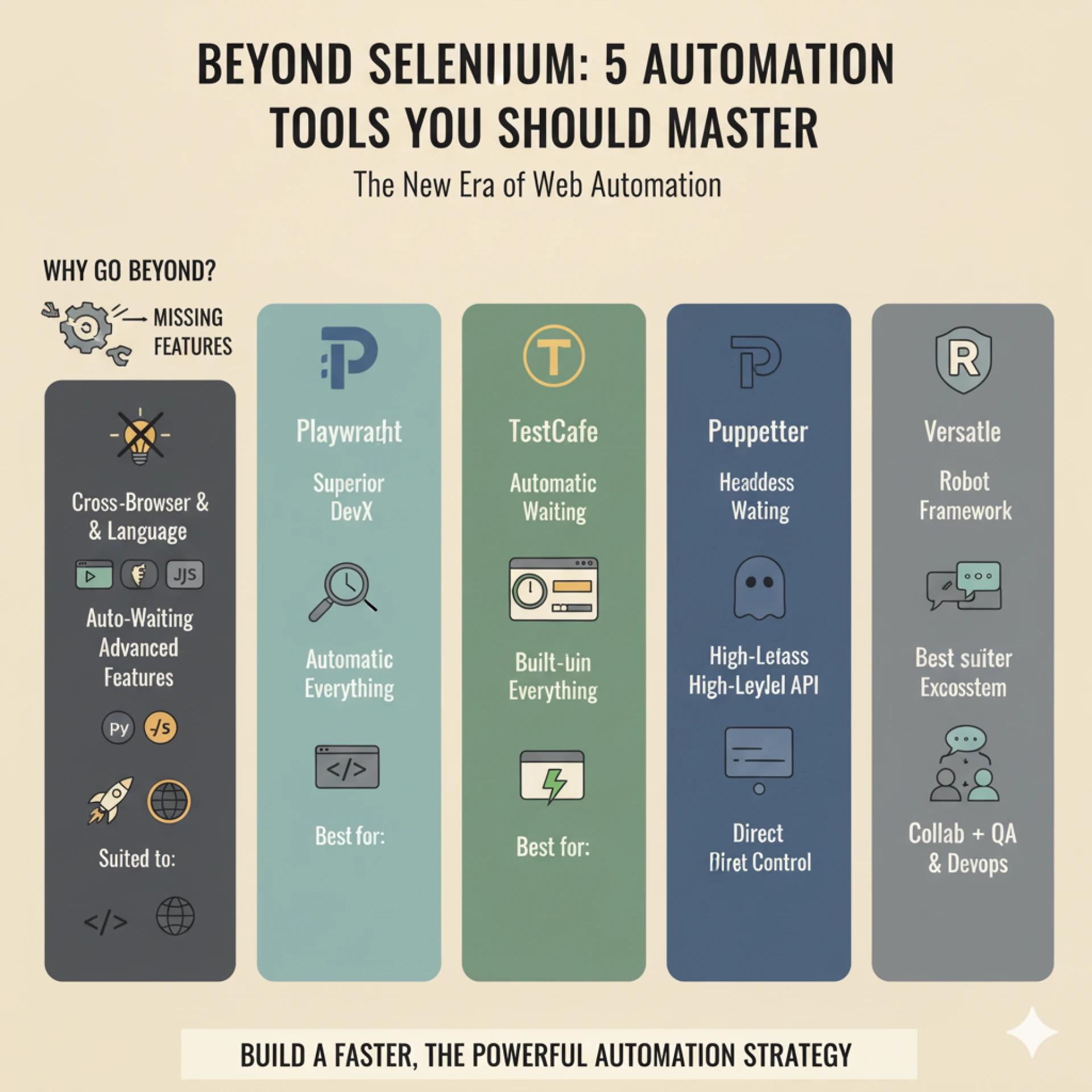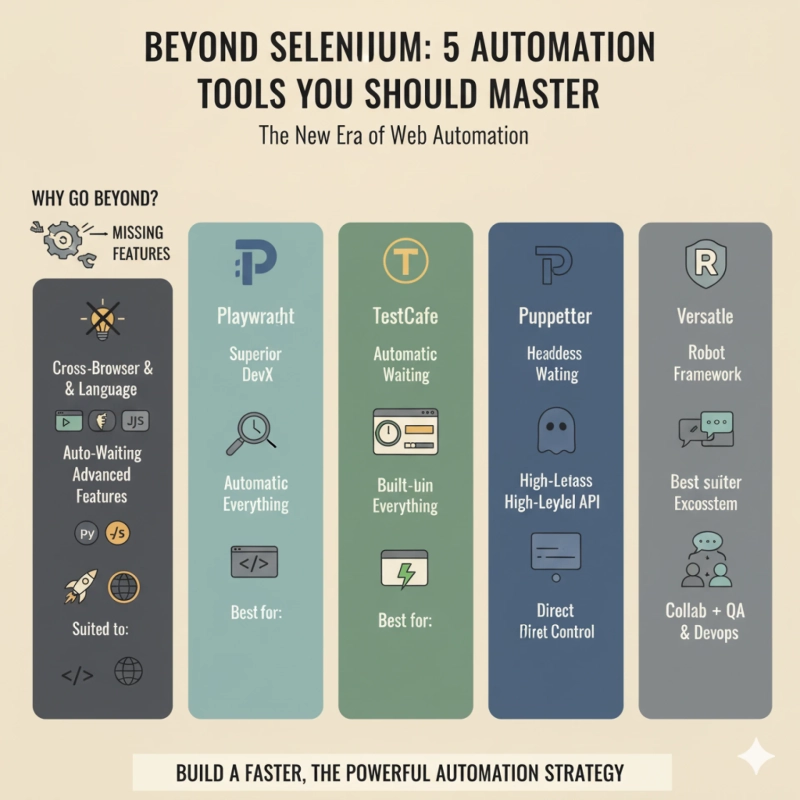Selenium has reigned as the champion of web automation for many years. Its open source, cross-browser compatibility, and flexibility caused it to be the tool of choice used by developers and QA engineers. But the current web has changed, and so has the automation testing world. Recently, a second generation of tools became available, which are more speedy, suited to human use by developers, and include features to help tests run more deterministically and without flaking.
Although Selenium is never going to become a thing of the past, these new tools are a must-have to remain a quality assurance leader. These are five automation testing tools to master besides Selenium.

Why Go Beyond Selenium?
An even more nuanced approach is the WebDriver architecture that uses a WebDriver API and a specialized driver per browser and can slow down with flaky tests. It also does not have descriptive features of functionality, such as automatic waiting, test reporting, and network control, and developers have to connect multiple third-party libraries to assemble a complex ecosystem of libraries to add these capabilities. The recent tools on the market are developed to address these issues.
1. Playwright
Developed by Microsoft, Playwright is a robust automation library that has risen through the ranks fast to become one of the favorites in town. It provides a new architecture, which directly communicates with the native API of browsers instead of through the WebDriver protocol, and makes testing faster and more reliable.
Key Strengths:
- Cross-Browser and Cross-Language: Playwright supports multiple browsers simultaneously—Chromium, Firefox, and WebKit (Safari)—all using the same API. It can also be used with other coding programs like JavaScript, Python, C++, and Java.
- Auto-Waiting: This mode automatically waits until the elements are actionable, and this has a significant effect in removing test flakiness.
- Advanced Features: The tool also has an intrinsic capacity to intercept networks and simulate mobile environments, as well as allow parallel testing without external add-ons.
Suited to: Teams that require a quick, stable, multi-language tool to perform end-to-end testing on a diverse collection of current browsers.
2. Cypress
Cypress is an end-to-end testing framework designed by developers. Cypress differs from Playwright and Selenium because it runs your tests in the browser and has native access to your application's DOM, providing a time-travel type of debugging.
Key Strengths:
- Superior Developer Experience: Cypress provides near-instantaneous reloads as well as a clear command log with integrated debugging tools that make developing and troubleshooting tests easy.
- Automatic Waiting: Automatic waiting of elements and commands: Waiting of automatic elements and commands is nearly without timing problems.
- Built-in everything: It has a test runner, an assertion library, and built-in capabilities to mock and stub, making its setup less complex.
Best suited to: Provides teams using JavaScript or TypeScript who need a fast, reliable, highly interactive end-to-end testing tool.
3. TestCafe
The TestCafe testing framework is simple and intuitive to use and has a very minimal setup. It runs tests on any platform, without the use of any browser plugin or WebDriver. It has its own special architecture whereby a proxy is introduced into a browser that communicates and automates everything.
Key Strengths:
- No WebDriver Needed: This also avoids the need to have external drivers managed, letting you set up and execute much more easily.
- Automatic Waiting: TestCafe automatically waits until page elements have finished loading, as well as asynchronous requests, which makes your test stable and reliable.
- Simple Syntax: Its syntax is quite clean and very easy to read; therefore, it is best suited to those whose fundamental knowledge is absent.
Best for: Teams looking to prioritize simplicity and easy use may want to choose this one, which will run fast and reliable tests without a complicated setup.
Teams should prioritize simplicity and ease of use, especially for rapid tests without complex setup procedures.
4. Puppeteer
Created by Google, it is a Node.js library with a high-level API designed to control Chromium and Firefox browsers remotely or locally using headless (or headful) mode.
Key Strengths:
- Headless Automation: Puppeteer is the best at running the automation of tasks in a headless browser, and it is ideal when web scraping, monitoring the performance, or producing PDFs or screenshots.
- High-Level API: It offers a straightforward browser API, which is simple and straightforward for developers.
- Direct Control: As it's a library, Direct Control enables direct, programmatic control over browser operations—perfect when scripting automation scripts yourself!
Best for: It provides direct, programmatic control over the browser, as it is a library, and this is perfect when the developer wants to write their own automation scripts.
5. Robot Framework
The Robot Framework is a brilliant selection when one deals with a combination of technical and non-technical members. It is a framework that is keyword-based and lets you write the test cases in a human-readable format, and thus can be easily contributed to by business analysts as well as QA engineers.
Key Strengths:
- Keyword-Driven: The test cases are written in an English-like, simple syntax, which is easy to read and maintain.
- Extensible: It can be extended to Python or Java libraries to allow libraries with a huge array of automation and an access point.
- Versatile: Although used to test websites, it can also test mobile, desktop, and API testing, which makes it a very versatile solution.
Best suited for: Agile teams with diverse skills that require a collaborative, keyword-based web automation framework and other forms of automation.
How to Choose the Right Tool
The selection of the appropriate tool will be based on the needs and knowledge of your team. Consider these factors:
- Language and Ecosystem: In case your team is familiar with JavaScript, Cypress, and Playwright are the best options. Playwright is also suitable for Python or Java shops.
- Developer Experience: Cypress is the best bet when you want to have a quick feedback loop with an excellent debugging experience.
- Cross-Browser Testing: Playwright outperforms it by far in cross-engine, cross-browser testing.
- Audience: Robot Framework is the best option in case your tests have to be read by non-technical stakeholders.
With the introduction of these advanced tools, you can build a test automation strategy that is faster, more scalable, and better aligned with the demands of modern web applications. While Selenium remains a valuable foundation, mastering complementary technologies enables teams to improve accuracy, reduce execution time, and deliver higher-quality releases.
For businesses aiming to strengthen their testing capability, investing in Selenium automation testing services or choosing to hire automation testers with multi-tool expertise can significantly elevate overall efficiency. By combining Selenium with next-generation frameworks, organizations can future-proof their QA processes and stay prepared for the evolving landscape of web automation.



